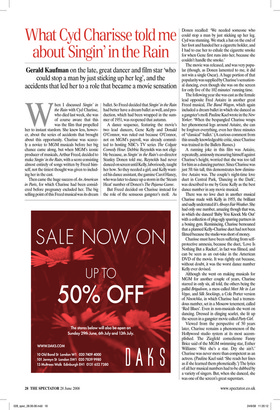What Cyd Charisse told me about Singin’ in the Rain
Gerald Kaufman on the late, great dancer and film star ‘who could stop a man by just sticking up her leg’, and the accidents that led her to a role that became a movie sensation When I discussed Singin’ in the Rain with Cyd Charisse, who died last week, she was of course aware that this was the film that propelled her to instant stardom. She knew less, however, about the series of accidents that brought about this opportunity. Charisse was scarcely a novice to MGM musicals before her big chance came along, but when MGM’s iconic producer of musicals, Arthur Freed, decided to make Singin’ in the Rain, with a score consisting almost entirely of songs written by Freed himself, not the tiniest thought was given to including her in the cast.
Then came the huge success of An American in Paris, for which Charisse had been considered before pregnancy excluded her. The big selling point of this Freed musical was its dream ballet. So Freed decided that Singin’ in the Rain had better have a dream ballet as well, and production, which had been wrapped in the summer of 1951, was reopened that autumn.
A dance sequence, featuring the movie’s two lead dancers, Gene Kelly and Donald O’Connor, was ruled out because O’Connor, not on MGM’s payroll, was already committed to hosting NBC’s TV series The Colgate Comedy Hour. Debbie Reynolds was not eligible because, as Singin’ in the Rain’s co-director Stanley Donen told me, Reynolds had never danced on screen until Kelly, laboriously, taught her how. So they needed a girl, and Kelly wanted his dance assistant, the gamine Carol Haney, who was later to dance up a storm in the ‘Steam Heat’ number of Donen’s The Pajama Game.
But Freed decided on Charisse instead for the role of the sensuous gangster’s moll. As Donen recalled: ‘We needed someone who could stop a man by just sticking up her leg. Cyd was stunning. We stuck a hat on the end of her foot and handed her a cigarette holder, and I had to cue her to exhale the cigarette smoke for when Gene first runs into her, because she couldn’t handle the smoke.’ The movie was released, and was very popular (though, as Donen lamented to me, it did not win a single Oscar). A huge portion of that popularity was supplied by Charisse’s sensational dancing, even though she was on the screen for only five of the 102 minutes’ running time.
The following year she was cast as the female lead opposite Fred Astaire in another great Freed musical, The Band Wagon, which again included a dream ballet in which she danced as a gangster’s moll. Pauline Kael wrote in the New Yorker: ‘When the bespangled Charisse wraps her phenomenal legs around Astaire, she can be forgiven everything, even her three minutes of “classical” ballet.’ (A curious comment from this usually knowledgeable critic, since Charisse was trained in the Ballets Russes.) A running joke in this film was Astaire, repeatedly, anxiously measuring himself against Charisse’s height, worried that she was too tall for him as a dancing partner. Since Charisse was just 5ft 6in tall, this demonstrates how diminutive Astaire was. The couple’s night-time love duet in Central Park, ‘Dancing in the Dark’, was described to me by Gene Kelly as the best dance number in any movie musical.
There was no love duet in another musical Charisse made with Kelly in 1955, the brilliant and sadly underrated It’s Always Fair Weather. She had only one number, amazing though that was, in which she danced ‘Baby You Knock Me Out’ with a collection of plug-ugly sparring partners in a boxing gym. Reminiscing, Charisse bemoaned that a planned Kelly–Charisse duet had not been filmed because the studio was short of money.
Charisse must have been suffering from selfprotective amnesia, because the duet, ‘Love Is Nothing But a Racket’, in fact was filmed, and can be seen as an out-take in the American DVD of the movie. It was rightly cut because, without doubt, it was the worst dance number Kelly ever devised.
Although she went on making musicals for MGM for another couple of years, Charisse starred in only six, all told, the others being the pallid Brigadoon, a mess called Meet Me in Las Vegas, and Silk Stockings, a Cole Porter version of Ninotchka, in which Charisse had a tremendous number, set in a Moscow tenement, called ‘Red Blues’. Even in non-musicals she went on dancing. Dressed in clinging scarlet, she lit up the screen in a gangster movie called Party Girl.
Viewed from the perspective of 50 years later, Charisse remains a phenomenon of the Hollywood studio system at its most accomplished. The Ziegfeld comedienne Fanny Brice said of the MGM swimming star, Esther Williams: ‘Wet she’s a star. Dry she ain’t.’ Charisse was never more than competent as an actress. (Pauline Kael said: ‘She reads her lines as if she learned them phonetically.’) The lyrics of all her musical numbers had to be dubbed by a variety of singers. But, when she danced, she was one of the screen’s great superstars.


















































































 Previous page
Previous page